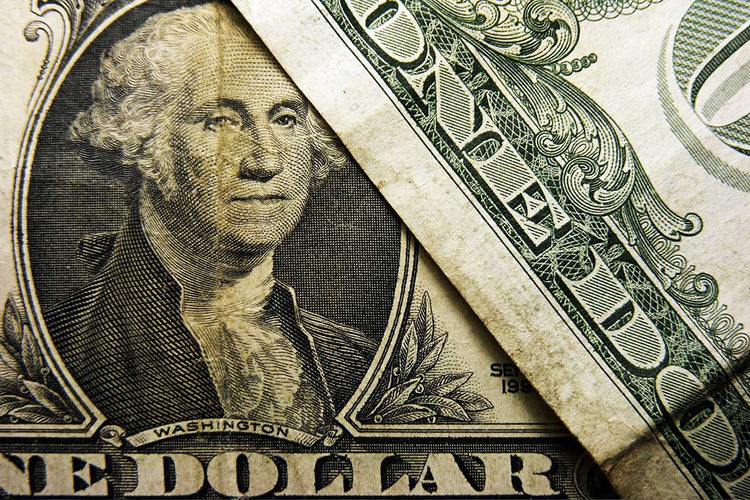Below patterns and designs that can be clearly seen lies the hidden secrets. Before we look at these hidden features of the dollar bill, let’s first explore those that are easily seen and understood.
Sitting majestically on the front of the dollar bill is a portrait of George Washington. This was a portrait by Gilbert Stuart that was never finished. To fit into the dollar bill, this image was flipped horizontally.
Just below the portrait, there are budding bay laurel leaves extending from both sides. These leaves have been used in history to represent status, and the fact that this one is budding shows that the United States has not reached its full bloom.
On the right of the dollar bill is the Treasury Seal. It features a balance which signifies justice, a key for trust and security, and a chevron with thirteen stars. Remember the number thirteen. It subtly hides itself in various parts of the dollar bill, and it holds its meaning.
On the left side is the seal of the Federal Reserve. On the ring around the letter, you will find which of the twelve Federal Reserve Banks a particular bill was printed. The letter at the middle of the ring also tells you the same but you will have to know which bank which letter represents. Each of these twelve banks has its own unique letter, and the serial number of each bill, found below this seal and above the Treasury Seal, starts with that unique letter.
On the bottom of the bill, below the Federal Reserve Seal is the signature of the treasurer of the United States. The signature of the secretary of the treasury is found on the other side and around this region you will find the series date which tells you the year the design for that particular bill originated.
Flipping it Over: Finding Secrets Behind the Dollar Bill
Boldly written behind the one dollar bill is “ONE.” This tells how many dollars the piece of paper is worth. Above this is the official motto of the United States adopted in 1956 “In God we trust.” On either sides of the “ONE” are circles showing the front and back of the National Seal.
On the left side is the Eagle, a national bird carrying a shield with thirteen stripes. Remember the number thirteen? The eagle is also holding an olive branch with thirteen leaves, and thirteen olive buds. With its other limb, the national bird firmly holds thirteen arrows and just above the eagle is a group of thirteen floating stars.
With its peak, the eagle holds a ribbon which reads “E Pluribus Unum” and translates to “Out of many, one.” Which indicates the coming together of thirteen colonies to become one.
Secret Meaning of the Olives and Arrows on the Dollar Bill
The Olives in the eagle’s claws is used to represent peace. At the same time, on its other limb are arrows used to represent war. This signifies that while the United States wants peace, she is ready for war should there be one. Furthermore, we can see the eagle looking at the olives meaning they are telling us that our nation would always prefer peace over war despite being ready for one.
On the other side of the banknote is the pyramid, the reverse side of the Great Seal. Just below the pyramid are the words “Novus Ordo Seclorum.” This translates to “A new order of the ages.” Above the pyramid are the words “Annuit Coeptis” which translates to “He has favored our undertaking.” At the pyramid’s foot is the roman numerals for 1776, the Year of Declaration of Independence. The pyramid itself represents strength and durability, and on a closer look you will discover it is incomplete and ends on the thirteenth layer.
Secrets of the Dollar Bill’s Eye of Providence
Right above the thirteenth level of the pyramid is the Eye of Providence – an eye within a triangle. There are various interpretations of this image. Many people believe it is a sign of illuminati and the Freemasons and its appearance on the dollar bill represents the influence of these groups on the government and treasury.
Irrespective of various beliefs, the Eye of Providence dates back as far as 1525 where it was painted by Jacopo Carucci above an image of three faces. Long before this event, the Eye of Providence “was an explicit symbol of the Christian Holy Trinity” according to Wikipedia. Through history, this symbol has been used to represent God watching over humanity.
Above the floating Eye of Providence are two words “Annuit Coeptis” which translates to “He has favored our undertaking.” “He” here is clearly used to refer to God and shows that the Eye of Providence is used in regards to its original meaning; God watching over us.
Judging from 1776 at the base of the pyramid indicating America’s founding year, the incompleteness of the pyramid, and the Eye of Providence above, we can come to a conclusion that this Pyramid represents America which gained independence in 1776, is still in the process of advancement and progression, and is being watched over by God.
About the Secret Hidden Spider on the Dollar Bill
The pattern around the one dollar bill resembles a spider’s web. Flip your bill to the front and look at the patterns surrounding the number “1” at the top corners of your bill. You will clearly see this as a spider web, and if you look closely at outside the borders of the top right “1” you can swear to see a spider which looks hidden. Some people even believe this to be an owl that signifies the freemasons but the web-like pattern makes the spider more authentic.
Sorry to burst your bubbles but this is neither a spider nor an owl. Flip your bill to the front and look at the bottom. Amidst the web-like patterns are two triangles one on each sides below the signatures of the treasurer and secretary of the treasurer. These triangles are highlighted in black and act as a point where all the lines in the web-like pattern meet. The spider by the “1” is another instance of this but the border surrounding the “1” has hidden most of it making it look like a small spider. It is also very easy to think of this as a spider as the dollar bill pattern looks like a web. Btw, that would be a lot of web for one tiny little spider to spun.

Secret of the dollar bill and the Number 13
From olives to arrows and stars, we can see the number 13 show itself in various ways across the one dollar bill. Look intensely and you may be lucky to find more groups of thirteen.
The number thirteen across the dollar bill is used to represent the thirteen colonies of the United States. It is known as The Thirteen Colonies and the Thirteen British Colonies. Yes, these were the British colonies. They were founded in 1604 and dissolved in 1776.
Conclusion
The dollar bill has a lot of hidden symbols and patterns that hold a significance for our history and our future. The imagery is spectacular but they are not mere images, patterns and symbols as we have seen in this exploration. So, the next time you handle a dollar bill, take a closer look and see how many hidden features you can spot with the help of a bill counter. Finally, what do you think about the dollar bill? Let us know through blog comment below.








4 comments
The open-mid front rounded vowel, or low-mid front rounded vowel, is a type of vowel sound, used in some spoken languages.
The symbol in the International Phonetic Alphabet that represents the sound is (œ). The symbol œ is a lowercase ligature of the letters o and e.
This is a fascinating and informative article about the hidden secrets of the one dollar bill. It’s amazing how many intricate details and symbols are embedded in this seemingly ordinary piece of currency. I have always been intrigued by the pyramid with the Eye of Providence on top, and it’s interesting to learn about its historical and religious significance. I also never knew about the spider web-like pattern on the bill, and it’s good to know that it’s not actually a spider or an owl.
My question is, do you think these hidden symbols and patterns on the dollar bill are just a coincidence or were they intentionally designed to convey certain messages and meanings? And if so, what do you think those messages and meanings are?
The word “Coeptis” on the back of the US $1 bill is actually part of a Latin phrase “Annuit Coeptis”, which translates to “He (God) has favored our undertakings”. The phrase was chosen by Charles Thomson, a Founding Father of the United States and the Secretary of the Continental Congress, to be included on the Great Seal of the United States, which appears on the back of the $1 bill.
The reason why the “o” and the “e” in “Coeptis” are combined together in a ligature is because it was a common practice in Latin handwriting to combine certain letters that appeared together frequently, such as “oe”, into a single character. This practice is known as a ligature, and it was used to save time and space in handwritten documents.
While it’s true that the “oe” ligature is the only instance of two letters being combined together on the $1 bill, it’s not the only example of a ligature on the bill. The letter “s” in “E Pluribus Unum” is also written in a ligature, with the stem of the “s” looping under the “u”.
Why is the o and the e in the word coeptis the only letters combined together on the entire $1 bill